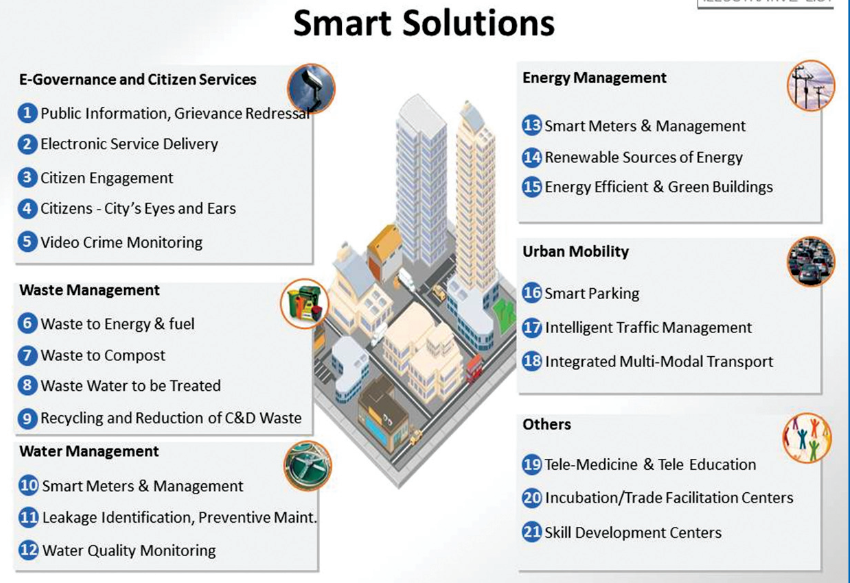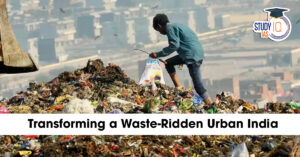Table of Contents
Context: Smart Cities mission nearly a decade later, has faced significant challenges and criticisms, leading to its perceived failure. According to a recent study by the Indian Institute of Management, Bangalore, the Introduction of smart classrooms under the Smart Cities Mission (SCM) has led to a 22% increase in overall enrolment as per data reported by 19 cities between 2015-16 and 2023-24.
| Key Highlights of the Report |
|
Smart Cities Mission (SCM)
- Launch: June 2015
- Valid Till: 31st March 2025
- Ministry: Ministry of Housing and Urban Affairs (MoHUA).
- Aim: To create 100 model cities for urban development.
- Key Components:
- Pan-city Proposals: IT-enabled services like mobility and waste management.
- Area-Based Development (ABD): Focused on retrofitting, redevelopment, and greenfield projects, confined to specific city zones.
- Governance Structure: Managed through Special Purpose Vehicles (SPVs) registered under the Companies Act, bypassing traditional city councils.
- Assumed private company-like governance would deliver better results, excluding local governments.

- Smart cities emerged post-2009 financial crash as urban areas akin to new Silicon Valleys, marked by extensive integration of airports, highways, and advanced ICT, forming intellectual cities.
- It was launched in 2015 by the Ministry of Housing and Urban Affairs.
- It aims to enhance the quality of life in 100 selected cities by providing efficient services, robust infrastructure and a sustainable environment.
- Initiated in June 2015 under the influence of global trends and the Jawaharlal Nehru National Urban Renewal Mission (JNNURM), the Smart Cities Mission (SCM) aimed to transform 100 cities over five years without a universally fixed definition, acknowledging that the concept could vary significantly based on local context and development levels.
Key Areas of Smart Cities Mission (SCM)
- The SCM focused on two aspects: area-based development (redevelopment, retrofitting, greenfield projects) and pan-city solutions based on ICT.
- Key areas included e-governance, waste management, water management, energy management, urban mobility, and skill development.

- The mission had a budget of ₹2 lakh crore of which 45 per cent is to be funded through Mission grants, 21 per cent through convergence, 21 per cent through PPP and the rest from other sources.
- Initially planned for completion in 2020, the mission was extended twice till June 2024.
- To implement the mission, a special purpose vehicle (SPV) led by bureaucrats or MNC representatives was established, sidelining traditional city governance structures.
Status of the SCM
- As of April 2024, 8,033 projects were sanctioned, but the total outlay fell to ₹1,67,875 crore, 16% less than projected.
- 5,533 projects worth ₹65,063 crore have been completed, while 921 projects worth ₹21,000 crore are ongoing.
- 400 projects in 10 cities are unlikely to meet the extended deadline of June 2024.
- PPP investments have been minimal, accounting for only 5% of the funding.
SAAR Initiative
- A platform was launched in 2022, named ‘SAAR’ (Smart Cities & Academia towards Action & Research) under SCM to bridge the gap between academia and government to document and research new urban initiatives.
- SAAR initiative includes the Sameeksha Series, which is a set of 50 impact assessment studies on Indian smart cities.
Challenges and Shortcomings of Mission
- Mismatch with India’s Needs: The Framework was based on the Internet of Things (IoT), ideal for advanced economies with existing infrastructure but less suited for India’s scenario of lacking basic services.
- Governance Issues: The governance model sidelined public involvement and local urban bodies, leading to a lack of ownership and accountability.
- Infrastructure and Retrofitting Challenges: Upgrading existing urban infrastructure to smart standards is complex and costly. Many cities lack comprehensive master plans, hindering the effective integration of smart technologies.
- Financial Constraints: Securing sustainable financing for smart city projects is a significant hurdle. Dependence on public-private partnerships and limited municipal revenues often lead to funding shortfalls.
- Governance and Coordination Issues: The creation of Special Purpose Vehicles (SPVs) to manage projects has sometimes resulted in overlapping responsibilities and coordination challenges among various governmental agencies.
Where did the SCM Falter?
- Flawed Selection Process: The competitive selection of 100 cities ignored the diverse urban realities in India.
- Exclusionary Approach: The scheme focused on developing only a small percentage (less than 1%) of a city’s area, leading to exclusionary development.
- Insufficient Funding: The total budget of ₹1,67,875 crore was inadequate compared to the estimated $1.2 trillion needed to make Indian cities liveable by 2030.
- Governance Issues: The SPV model was not aligned with the 74th Constitutional Amendment and was criticised for being top-down and disconnected from local needs.
- Displacement and Flooding: The SCM led to the displacement of people from poorer areas and increased urban flooding due to infrastructure projects disrupting water channels.
| Case Study: Shimla Smart City |
Outcomes and Failures
Lessons and Implications
|
Special Purpose Vehicle (SPV)
- Implementation of the Mission at the City level will be done by a Special Purpose Vehicle (SPV) created for the purpose.
- The SPV will plan, appraise, approve, release funds, implement, manage, operate, monitor and evaluate the Smart City development projects.
Way Forward
- Comprehensive Planning: Develop detailed city development plans that integrate smart solutions with existing urban frameworks.
- Innovative Financing: Explore diverse funding sources, including municipal bonds and international collaborations, to ensure financial sustainability.
- Strengthened Governance: Enhance coordination between SPVs and local governments to streamline decision-making processes.
- Capacity Building: Invest in training urban planners and officials in the latest technologies and data management practices.
- Public Engagement: Implement initiatives to raise awareness and involve citizens in the planning and monitoring of smart city projects.


 New Window of Opportunity for India amid...
New Window of Opportunity for India amid...
 Cetacean Morbillivirus: Meaning, Feature...
Cetacean Morbillivirus: Meaning, Feature...
 Transforming a Waste-Ridden Urban India:...
Transforming a Waste-Ridden Urban India:...

























